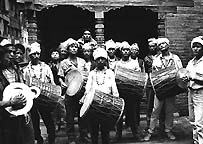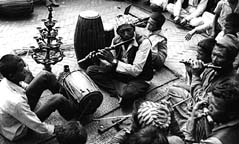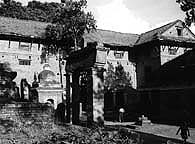 The musical traditions of Nepal are as diverse
as the various ethnic groups of the country. Arguably the most complex
musical culture in the Himalayas is that of the Newar people in the Kathmandu
Valley which in the course of the past two thousand years has absorbed
mostly Indian influences shaping a unique musical tradition.
The musical traditions of Nepal are as diverse
as the various ethnic groups of the country. Arguably the most complex
musical culture in the Himalayas is that of the Newar people in the Kathmandu
Valley which in the course of the past two thousand years has absorbed
mostly Indian influences shaping a unique musical tradition.
The Newar culture flourished during the late Malla dynasty from the 15th century up to the 18th century. The Malla kings of Kathmandu, Patan and Bhaktapur were devoted patrons of the arts and competed with one another in the beautification and cultural achievements of their kingdoms. Many of these Malla kings excelled as musicians, dancers, poets and town planners.
 The musical traditions of Nepal are as diverse
as the various ethnic groups of the country. Arguably the most complex
musical culture in the Himalayas is that of the Newar people in the Kathmandu
Valley which in the course of the past two thousand years has absorbed
mostly Indian influences shaping a unique musical tradition.
The musical traditions of Nepal are as diverse
as the various ethnic groups of the country. Arguably the most complex
musical culture in the Himalayas is that of the Newar people in the Kathmandu
Valley which in the course of the past two thousand years has absorbed
mostly Indian influences shaping a unique musical tradition.
 The Newar culture flourished during the late
Malla dynasty from the 15th century up to the 18th century. The Malla
kings of Kathmandu, Patan and Bhaktapur were devoted patrons of the arts
and competed with one another in the beautification and cultural achievements
of their kingdoms. Many of these Malla kings excelled as musicians, dancers,
poets and town planners.
The Newar culture flourished during the late
Malla dynasty from the 15th century up to the 18th century. The Malla
kings of Kathmandu, Patan and Bhaktapur were devoted patrons of the arts
and competed with one another in the beautification and cultural achievements
of their kingdoms. Many of these Malla kings excelled as musicians, dancers,
poets and town planners.
Dramatic changes can be seen not only among the Newar but also among all ethnic groups of Nepal - even in areas far from the Kathmandu Valley. What Nepalese perceive as 'the loss of our culture' happens at a rapid pace and goes along with the ravaging of the natural environment, an alarming population growth, unbalanced distribution of resources, rampant exploitation and corruption, political instability and a growing desperation and readiness to solve problems not through compromise but with violence. Current change devastates Nepal like a wild river. This must be controlled and channelled into a less destructive course. Preservation of culture and environment is a precondition for sustainable development. In this context, the academic discipline of ethnomusicology could play an important part.
 The aim of the K.U. Department of Music is to train competent musicians
and ethnomusicologists to document, preserve, and work creatively with
the endangered musical traditions of Nepal. As Bhaktapur is considered
by many to be the capital of the performing arts, this traditional farmers'
town is an ideal laboratory for students of ethnomusicology.
The aim of the K.U. Department of Music is to train competent musicians
and ethnomusicologists to document, preserve, and work creatively with
the endangered musical traditions of Nepal. As Bhaktapur is considered
by many to be the capital of the performing arts, this traditional farmers'
town is an ideal laboratory for students of ethnomusicology.